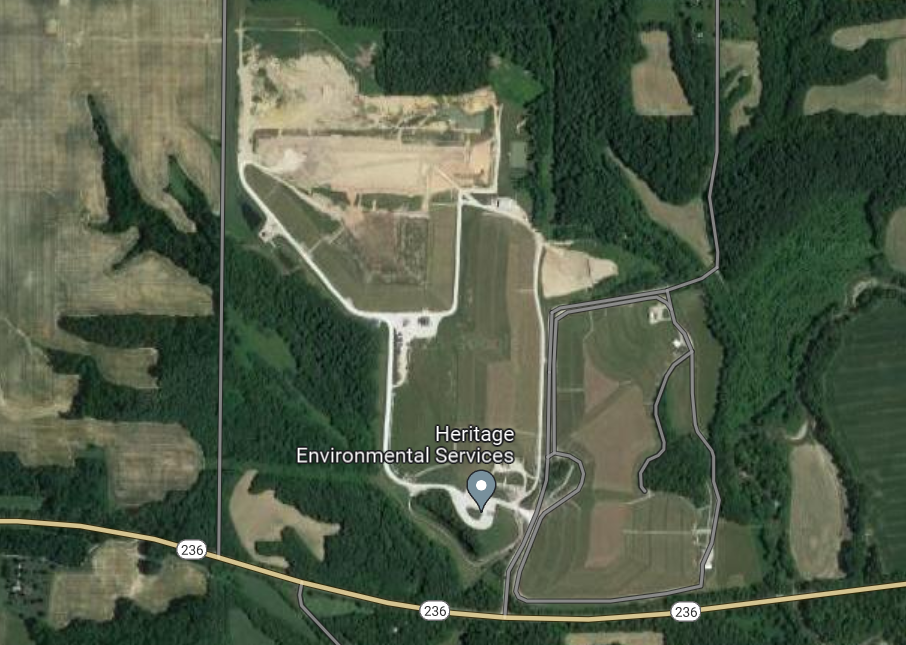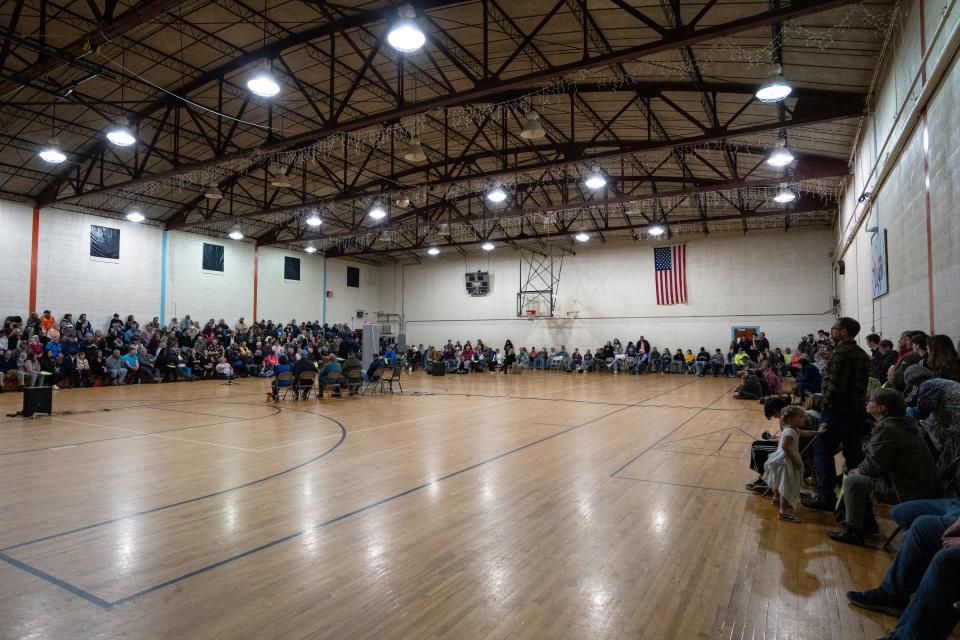Hazardous waste landfills safe, but concerns linger over toxic soil coming to Indiana
Hundreds of tons of contaminated soil and millions of gallons of water have been collected from East Palestine, Ohio, after a train derailment last month released toxic chemicals into the surrounding air, water and ground.
The waste from the site has to go somewhere, but the question becomes: Where to put it?
A landfill about 40 miles west of Indianapolis is among seven facilities in four different states that have been designated to take some of the material. It has already received three shipments of contaminated soil from the wreck site, a development that has raised serious concerns among officials including Indiana Gov. Eric Holcomb and residents who live near the landfill.
Some of the chemicals that spilled in the train crash, along with possible byproducts from the fire, are known to cause cancer. Others can cause headaches, difficulty breathing or skin and eye irritation.
Railroad safety: Indiana communities at risk for train disasters like the one that devastated Ohio town
The potential for harm has many Hoosiers questioning if Indiana is the right place for the Ohio waste. They fear it could put them at risk.
“The materials should go to the nearest facilities, not moved from the far eastern side of Ohio to the far western side of Indiana,” Holcomb said last week. “I want to know exactly what precautions will be taken in the transport and disposition of the materials.”
But scientists and hazardous waste experts say they aren’t overly concerned.
Landfills like the one in Putnam County are designed and built to handle toxic waste, they said. They also have processes in place to protect the surrounding environment.
“When hazardous waste landfills are properly run and maintained, then it is not a problem for the surrounding environment or the people living there,” said Marta Venier, an environmental chemist at Indiana University.
However, the Indiana landfill has had some alleged issues in recent years, according to a compliance database from the U.S. Environmental Protection Agency. That raises questions for some about the facility, operated by Heritage Environmental Services, and whether it is equipped to properly handle the waste.
The company is working to calm those concerns and says the alleged violations cited by the EPA relate to a minor disagreement over labeling.
“We have operated in the community since 1980 and continuously strive to be a good neighbor and corporate citizen,” Heritage vice president Ali Alavi told IndyStar in an emailed response. “We are happy to engage with the community and believe it is important to maintain an open dialogue.”
Landfills designed to handle toxic waste
The Indiana landfill sits in a rural area between the towns of Roachdale and Russellville. It is certified to handle hazardous waste. On its website, Heritage said that it has roughly 14 million cubic yards of permitted landfill capacity and that the landfill is geologically isolated.
Landfills like this one are specifically engineered sites where non-liquid hazardous waste is disposed of and covered. The sites have to be designed in a particular way to “minimize the chance of release of hazardous waste into the environment,” according to the EPA.
While most regular landfills for sanitary waste — think every day household trash — have one liner, hazardous waste landfills have at least two, said Chris Kohler, a professor at IU who also has a long career working with hazardous waste and contaminated sites.
The liners are made with impermeable materials. In addition to the liners, there are layers of clay, soil and other materials. In between the liners, there are sensors to detect leaks from a tear or other damage. The landfills also have leachate collection systems to capture anything that comes out of the landfill and remove it to be treated, Kohler explained.

Spaced along the perimeter of the Roachdale landfill is a network of 15 wells used to monitor the groundwater around the site, according to the Indiana Department of Environmental Management. Heritage tests the groundwater semi-annually, the agency said, and the company has not detected any pollutants above acceptable levels.
Heritage “is in compliance with its permit,” IDEM told IndyStar.
Kohler said hazardous waste is typically treated — often before it even comes to the landfill — or is encapsulated in a way to reduce the level of potentially harmful chemicals before it is put in the ground. He said precautions are taken throughout the process to reduce the risk and ensure the material is contained safely.
“Landfills are not just a hole in the ground,” Kohler said. “They’ve been engineered to contain the waste.”
Past violations raise concerns
For many, their concerns stem from uncertainty: What is in the waste and will the facility will meet its duty to handle it properly?
At a community meeting on March 1, residents asked about past issues at the site. It had 12 quarters of noncompliance with federal regulations dating back to the spring of 2020, according to the EPA’s Enforcement and Compliance History Online database.

A document from IDEM to the company also cites issues discovered during a 2019 inspection. They include a failure to meet sampling requirements, a bag with hazardous debris that ignited, and liquid found in a trailer.
But a response from the company to the state agency argues the waste had already been treated and encapsulated, so they didn’t need to sample it. They also said they’ve addressed the ignition issue and the liquid was in the transport truck and did not leak from the bag of hazardous waste.
Alavi said the alleged EPA noncompliance involved a “disagreement over the level of detail required on a label” and the issue was addressed. The company also stressed that while negotiations on resolving the paperwork are ongoing, it does not mean violations at the site have continued.
“The official closing of a file often is over a year after the alleged violation has been addressed and a resolution agreed upon,” Alavi told IndyStar. “Thus the misleading appearance of a violation extending for multiple quarters when it actually promptly was resolved."
He added the EPA database does not distinguish between what is considered a minor issue, like paperwork, compared to something more serious like a spill.
Hazardous materials: 'We don't trust you' — Indiana landfill neighbors don't want toxic waste from Ohio train
While IDEM would not comment on the ongoing compliance case, as it is still open, the agency did tell IndyStar that “this issue does not pertain to the landfill’s ability to accept or appropriately manage hazardous waste.”
The EPA also said that it determines if a disposal facility is in compliance with hazardous waste laws and is acceptable to receive the waste before approving debris to be moved there. EPA told IndyStar that the landfill near Roachdale "is acceptable” for receiving the wastes from the train wreck.
Future shipments of contaminated soil
Several shipments of waste have already been received at the site. Alavi said it is unclear how much waste in total is expected to come to the Indiana landfill.
The material is being shipped by truck and is safely closed and sealed on all sides, Alavi said.
Gabe Filippelli, executive director of the Environmental Resilience Institute, said he recognizes the material is potentially dangerous to the environment and public health, “thus the need to get it disposed of.” His main concern, he said, is that the trucks transporting the material could have an accident themselves and cause the potential for an additional spill somewhere in the delivery chain.
The shipments of waste from the Ohio site have been paused temporarily. The EPA said it is testing the soil for dioxins, a “highly toxic” chemical compound that can cause cancer and takes a long time to break down in the environment.

Holcomb has also ordered testing for dioxins in the contaminated soil that has already been delivered to the landfill. The Heritage site is not permitted to receive certain hazardous waste streams that contain dioxins, Alavi said, but it can accept dioxins that are naturally occurring or in wastes at trace amounts below specific levels.
The results, which were announced Wednesday, showed that the contaminated soil does not contain any harmful levels of dioxins, according to a release from the Governor. That means the landfill is lawfully permitted to dispose of that material at its site. Still, Holcomb added that the state will continue to test any further shipments brought to Indiana.
Kohler said these facilities are receiving various types of hazardous waste on a regular basis, some potentially more harmful than the material from Ohio. Filippelli said that is the “conundrum” with the country’s use of hazardous materials for industrial purposes: “What do you do with it afterwards or in this type of situation?”
Some materials can be incinerated, which is the case for some of the waste from the train derailment. For others, the only solution is disposal at a hazardous waste facility. Filippelli stressed that continued and long-term monitoring is important to ensure all the safety systems are working properly to prevent an unexpected release into the environment.
Venier, the chemist, said she is not concerned with the waste coming to Indiana, adding the risk of exposure like what was experienced in East Palestine after the crash is very different from that posed by the waste.
“There is a lack of trust between people and institutions, which is unfortunate. But these facilities are monitored much more than other places where this waste could have gone,” she said. “So this is the best way to do this.”
Call IndyStar reporter Sarah Bowman at 317-444-6129 or email at sarah.bowman@indystar.com. Follow her on Twitter and Facebook: @IndyStarSarah. Connect with IndyStar’s environmental reporters: Join The Scrub on Facebook.
IndyStar's environmental reporting project is made possible through the generous support of the nonprofit Nina Mason Pulliam Charitable Trust.
This article originally appeared on Indianapolis Star: Experts say hazardous waste landfills are safe, but concerns linger

